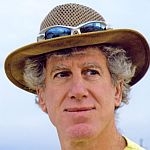 (Host) A number of years ago, naturalist and commentator Ted Levin was
(Host) A number of years ago, naturalist and commentator Ted Levin was
passing through Miami International Airport, when he encountered an
unexpected reminder of home.
(Levin) I was headed home to Vermont
when a chatty skycap asked me if I knew Ben Kilham, from Lyme, New
Hampshire. I told him I did. Then, from the kiosk the skycap pulled out a
well-worn copy of Kilham’s book Among the Bears, and said, "I want to
raise orphan bear cubs too and set them free."
I must admit the congestion in front of the American Airlines desk made the back woods of Lyme seem pretty good to me, too.
I
visited Kilham again recently, after a long, slow drive into the
hinterlands beyond the Dartmouth Skiway. At the time, he was caring for
twenty-seven orphaned cubs – twenty in an eight-acre enclosure and seven
in a bear barn. The cubs in the enclosure arrived nearly a year ago and
had to be bottle-fed. Those in the bear barn arrived this past October
and are still getting used to life as orphans.
To help them
adjust, a playful Massachusetts cub named Slothy serves as an ursine
ambassador. "She gets the traumatized cubs to relax," Kilham told me, as
we sat at the dining room table, observing a fidgety cub by bear-cam,
one of six surveillance cameras that feed images to his i-pad.
Over
the years, Kilham has discovered that black bears are not solitary
mammals, loners that divvy up the woodland resources and cautiously
avoid each other. To the contrary, he says they’re quite social. They
only appear solitary relative to the food supply. If food is abundant,
bears follow a quite elaborate social system.
Bears may have
expressive faces, but like dogs, they read the world mostly with their
noses. They leave olfactory messages throughout the forest. They also
scratch the soft bark of red pines, turn over rocks, and rub tufts of
fur onto tree trunks, all of which has meaning to other bears. It’s been
common practice for bear rehabilitators to try to minimize human
contact with orphaned cubs, but not Ben Kilham.
The idea that
even if a bear doesn’t see you, you are always making contact, is the
essence of Kilham’s rehabilitation. He bonds with the cubs.
He
walks them in the woods, leads them to appropriate food sources, and
essentially becomes their substitute mother. To get to know him, the
tiniest cubs stick their tongues in his mouth.
I wondered if
they would be attracted to people when he released them, but Kilham
doesn’t think so. "No," he says. "You’re not going to walk up and hug a
stranger… You’re not going to get the same signals from the stranger
you’d get from a close friend."
Recently, China asked Kilham to
teach their scientists how to prepare captive-bred panda cubs for
release into the wild. When I asked him if pandas are harder to work
with than black bears, Kilham replied that a bear is a bear.
And Ben
Kilham ought to know.